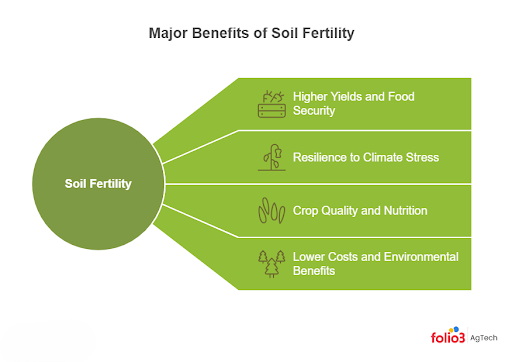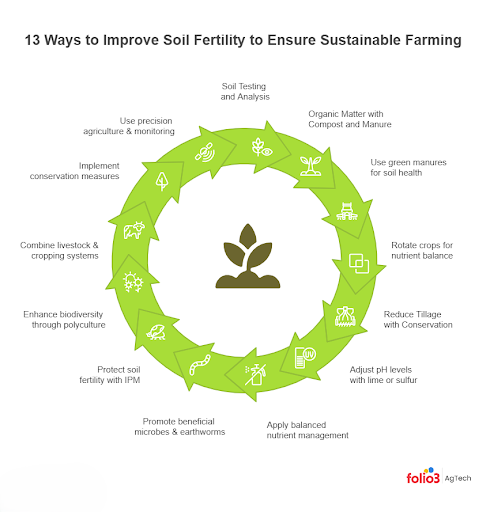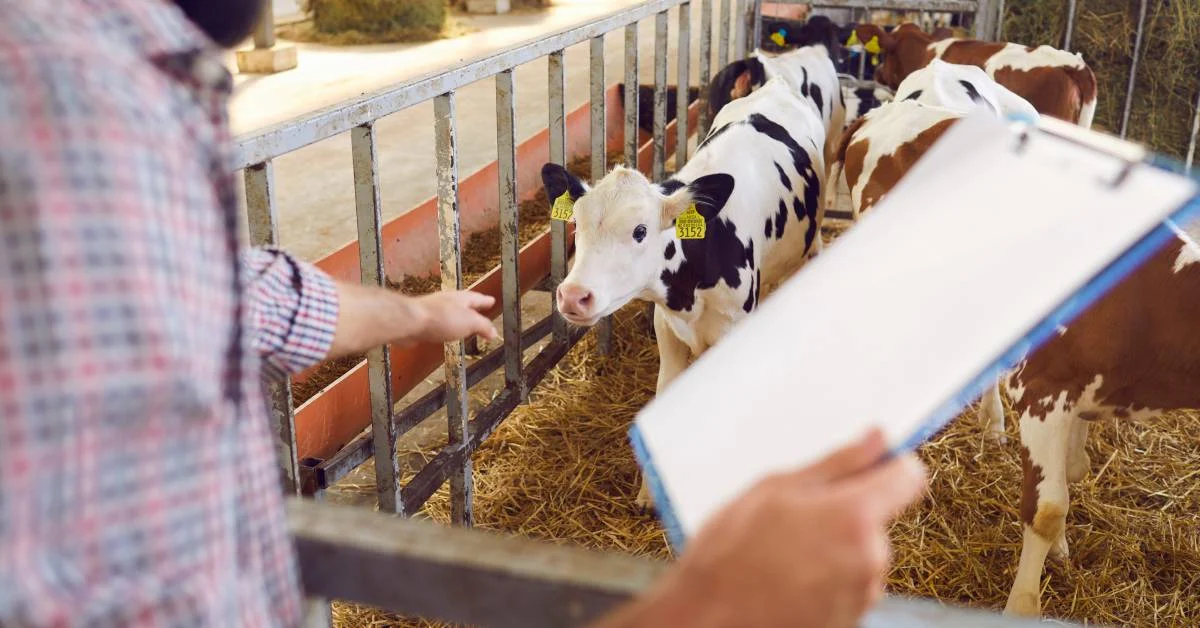Modern farmers and gardeners face a stark challenge: soils worldwide are losing their fertility faster than ever due to climate and environmental change. Every year, billions of tonnes of topsoil erode due to overgrazing, deforestation, and unsustainable practices. The impact is already visible as parts of the U.S. Corn Belt that have lost fertile topsoil now produce about 6% less grain, even with heavy fertilizer use.
The typical response is to pour on more chemical fertilizer, but that’s only a costly band-aid. Research shows that nearly one-third of the fertilizer applied in U.S. corn fields is simply replacing lost soil fertility, draining over $500 million annually from farmers’ pockets. Beyond the economic hit, declining soil health makes crops less resilient to droughts, floods, and pests, and can even reduce the nutritional quality of food.
The good news? You don’t have to accept declining soil as the norm. There are proven, field-tested methods to improve soil fertility naturally, helping you rebuild soil health, increase yields, and create more resilient farmland for the future. In this blog, we’ll walk through practical, science-backed ways to restore and maintain fertile soil, so your crops thrive season after season.
What is Soil Fertility in Agriculture?
Soil fertility refers to the soil’s natural capacity to support plant growth by providing essential nutrients, water, and a hospitable root environment. In practical terms, fertile soil lets your crops thrive with fewer added inputs. It’s the kind of soil where nutrients are available, roots grow freely, and beneficial organisms thrive underground. Usually, dark color, crumbly texture, and that earthy smell are all signs of soil that can sustain healthy plants.
Key components that determine how to improve soil fertility include:
- Nutrients (Macro & Micro): Fertile soils supply macronutrients like nitrogen (N), phosphorus (P), and potassium (K), plus micronutrients like zinc, boron, and iron. Each plays a vital role: nitrogen fuels leafy growth, phosphorus builds strong roots and fruits, and potassium boosts plant health.
- Soil Texture & Structure: The mix of sand, silt, and clay affects aeration, drainage, and root penetration. Loamy soils with good structure provide air and water balance, resist compaction, and help reduce erosion. Crumbly, friable soils make it easier for roots to explore and absorb nutrients.
- Organic Matter & Microbial Activity: Humus; fully decomposed organic matter enriches structure and cycles nutrients. It supports microbes, fungi, and earthworms that decompose residues, release nutrients, and improve soil aeration. These living organisms are what make the soil fertile.
- Moisture Retention: Fertile soils act like sponges, holding water yet draining well. It means fertile soils stay moist longer after rain, providing plants with a steady water supply and buffering against drought.
- Soil Fertility vs. Productivity: Fertility is the soil’s inherent capacity to supply nutrients, while productivity is the actual yield. You can improve soil fertility naturally, but productivity also depends on climate, crops, and management. Sustainable farming practices aim to build fertile soils that deliver resilient productivity with fewer inputs year after year.
Why Soil Fertility Matters?
Improving and maintaining soil fertility is the backbone of productive farming. Here’s why it matters for your fields and crops:

1. Higher yields and food security. Fertile soil grows more food. Nutrient-rich, well-structured soils let crops reach full potential, while depleted soils cause stunted plants and yield losses. Losing just 1 inch of topsoil can cause declines that are hard to recover. In regions like sub-Saharan Africa, decades of nutrient depletion have stalled production.
2. Resilience to climate stress. Fertile soils buffer weather extremes. A 1% increase in soil organic matter enables an acre to hold over 16,500 extra gallons of water. That means crops survive short droughts, while good structure also improves drainage after heavy rains.
3. Crop quality and nutrition. Fertile soils support healthier, more nutritious harvests. Balanced nutrients, including micronutrients like zinc and iron, often translate into better flavor, fuller grain, and higher market value. Healthy soils also strengthen natural disease resistance.
4. Lower costs and environmental benefits. Fertile soils reduce reliance on fertilizers and pesticides. Building soil health saves money, cuts erosion, and reduces runoff, keeping nutrients in your field and waterways cleaner.
In short, soil fertility drives yield, resilience, quality, and profitability. Now, let’s dive into the practical ways you can improve soil fertility, naturally and sustainably.
13 Ways to Improve Soil Fertility to Ensure Sustainable Farming
How to increase soil fertility? Below are the proven methods validated by research based on organic farming, agroecology, and soil science that will enhance the fertility of your soil. Using these strategies is mutually supportive; you’ll often get the best results by combining several of them in an integrated approach tailored to your farm or garden. Let’s build up that soil!

1. Start with Soil Testing and Analysis
If you want to improve soil fertility, the first step is knowing exactly what’s in your soil. A soil test provides a scientific snapshot of nutrient levels, nitrogen (N), phosphorus (P), potassium (K), pH, and sometimes micronutrients. This baseline removes guesswork. For example, a test may reveal low phosphorus or acidic pH. So, adding nitrogen won’t fix a phosphorus deficiency, and plants can’t use nutrients if the pH is too far off. By testing, you’ll know precisely what your soil needs, nothing more, nothing less.
How is soil fertility enhanced through testing? By targeting the exact interventions your soil requires.
- Collect samples: Take soil from 0–6 inches deep across your field in a zigzag pattern. Mix subsamples to get an accurate representation, avoiding unusual areas like compost piles.
- Send to a lab: Extension services and soil labs provide affordable, detailed analyses. Ask for a complete fertility test covering pH, organic matter, N, P, K, and key micronutrients.
- Read results carefully: Reports flag low or high nutrients and recommend fixes. If potassium is low, apply potash; if pH is 5.5, lime is suggested to raise it closer to 6.5.
- Adjust your plan: Follow recommendations for fertilizer or amendments, and retest every 2–3 years. This keeps your fertility plan on track, prevents waste, and ensures steady progress toward healthier, more productive soil.
2. Add Organic Matter with Compost and Manure
If you’re asking how to improve soil fertility naturally, the answer almost always begins with organic matter. Compost, manure, and residues fuel the soil food web while transforming into humus, the dark, stable material that makes soil spongy, nutrient-rich, and biologically active. Unlike chemical fertilizers that only feed plants directly, organic matter strengthens the entire system: it improves soil structure, prevents nutrient leaching, and boosts microbial life. As a result, the fields treated with manure year after year consistently outperform fertilizer-only fields because the soil itself becomes healthier and more resilient.
Here’s how you can put this into practice on your farm or garden:
Apply Compost Regularly
Use fully decomposed compost once a year (2–5 tons/acre or 1–2 inches in gardens). Properly matured compost avoids plant burn and steadily improves tilth, water-holding capacity, and microbial diversity.
Use Aged Manure
Well-rotted cow, sheep, or poultry manure adds balanced nutrients and carbon. Incorporating it right after spreading reduces nitrogen loss, odor, and weed-seed risks.
Recycle Crop Residues
Instead of burning stalks or straw, chop and return them to the soil. Over time, residues build organic matter and recycle nutrients, especially when paired with a legume cover crop.
Monitor Organic Matter Levels
Test your soil regularly; if levels stay below 3%, increase applications. With consistent additions, soil becomes darker, easier to work with, and unmistakably fertile.
3. Plant Cover Crops (Green Manures)
How does green manure improve soil fertility? Growing cover crops (green manures) during the off-season protects and enriches soil by adding organic matter and naturally increasing nutrients like nitrogen. These crops aren’t grown for harvest but to cover and heal the soil. Legume covers like clover, vetch, and peas partner with soil bacteria to fix atmospheric nitrogen, often adding 50–150 lbs/acre for the next crop. Their biomass becomes organic matter, boosting soil carbon, structure, and microbial life.
Now let’s look at practical steps to use them effectively:
- Choose the right cover: Match crops to your goals, legumes for nitrogen, cereals for biomass, buckwheat or mustard for fast weed suppression.
- Plant at the right time: Keep soil covered whenever it would otherwise be bare. Sow winter covers after harvest in late summer/fall, or summer covers between spring and fall crops.
- Terminate and incorporate correctly: Cut, crimp, or till at flowering to maximize biomass and nutrient release. Wait 2–3 weeks before planting cash crops if residue is high-carbon (e.g., rye).
- “Green manure” usage: For soil building, till in lush growth and allow 2–4 weeks to decompose. It releases nutrients gradually, preventing seed set to avoid volunteer problems.
- Repeat and diversify: Use covers yearly where possible. Rotate species or plant cocktails for deeper soil benefits from radish breaking compaction to multi-species mixes feeding diverse microbes.
4. Practice Crop Rotation for Nutrient Cycling
How does crop rotation improve soil fertility? Changing what you grow in a field each season supports nutrient cycling and breaks pest/disease cycles. Different crops draw and return different nutrients, so rotating prevents repeated depletion and can add fertility. A legume year (soybeans, alfalfa) enriches soil nitrogen for a following heavy feeder (corn). Research from Iowa State shows corn–soybean rotations can reduce synthetic N needs via the soybean credit.
Now, translate that science into a plan for your fields:
Plan a multi-year sequence: List crops by family and feeding habit, then alternate heavy feeders with legumes or lighter feeders. Aim for at least a 3-year rotation (e.g., corn → soybeans → wheat + cover) or a 4-year garden sequence.
Include a fertility-building crop: Insert a legume cover or forage phase to rebuild nitrogen and organic matter. Even interseeding clover after a grain adds measurable fertility; a year of alfalfa or clover-grass can reset soil health and fuel subsequent yields.
Alternate deep and shallow roots: Follow shallow-rooted crops with deep-rooted species (sorghum, sunflower, alfalfa) to lift nutrients from depth, relieve compaction, and leave biopores that improve drainage for the next crop.
Break pest and disease cycles: Avoid planting the same crop family consecutively. Insert non-host years and strategic covers to reduce pathogen and nematode pressure, improving root vigor and nutrient uptake.
Stay flexible but track rotation: Weather and markets change, adapt without abandoning principles. If a fertility-building phase is skipped, compensate with compost or green manure.
5. Reduce Tillage with Conservation or No-Till Practices
Minimal soil disturbance is key to preserving structure and fertility. Tillage exposes organic matter, accelerates its breakdown, and releases carbon, while also destroying soil aggregates and increasing compaction and erosion. By reducing tillage, you protect soil life, microbes, fungi, and earthworms that build humus and recycle nutrients. A US study found that no-till fields had nearly double the earthworm population compared to plowed fields, with much higher microbial biomass. Reducing tillage also saves fuel and labor, adding to sustainability.
To put reduced tillage into practice, here are the steps to follow:
- Adopt no-till or strip-till: Use drills or planters that place seeds directly into residues. Strip-till disturbs only narrow seed rows, balancing soil protection with seedbed preparation.
- Manage residues and weeds: Keep crop residues on the surface to shield soil. You can control weeds with cover crops, mulches, or integrated weed strategies instead of relying heavily on herbicides.
- Avoid soil compaction: Schedule fieldwork during drier conditions, use controlled traffic lanes, and plant deep-rooted species like radish or rye that naturally break compacted layers.
- Be patient: The transition may take a few years. Initially, soils can look uneven, but gradually, fertility improves, water-holding capacity rises, and soil becomes healthier.
6. Maintain Proper Soil pH
Soil pH is the master control for nutrient availability and microbial activity. Most crops thrive between 6.0–7.0, but when pH drifts too low or high, nutrients get locked away. Moreover, adjusting pH unlocks existing nutrients, improves root health, and creates conditions where soil microbes thrive. Research shows liming acidic soils can boost yields by 36% on average while reducing aluminum toxicity and enhancing nutrient uptake.
To translate these methods into action, here’s how you can test and adjust soil pH for healthier, more fertile fields:
- Test and target pH: Use a soil test to find your baseline. Aim for 6.0–6.8 for most crops, ~6.5 for legumes, and 5.5–6.0 for acid-loving plants like blueberries. Results guide whether to lime or acidify.
- Apply lime to raise pH: Agricultural lime (calcium carbonate) is the standard amendment. Apply at recommended rates (1,000–4,000 lbs/acre depending on test results) several months before planting, and incorporate into the topsoil for best effect.
- Use sulfur to lower pH: For alkaline soils, elemental sulfur slowly lowers pH as microbes convert it to sulfuric acid. For gardens, iron or aluminum sulfate can provide quicker adjustments, while organic matter and ammonium fertilizers help maintain acidity.
- Ensure even incorporation: Amend the top 6–8 inches of soil where roots grow. In orchards or no-till, surface applications work more slowly but are still effective with time.
- Watch plant indicators: Crops showing yellowing (iron chlorosis) or weeds like sorrel (acid soils) can reveal hidden pH problems. Correcting pH often makes these symptoms disappear.
7. Use Natural Fertilizers and Balanced Nutrient Management
Even if you build organic matter, most soils still need added nutrients to stay productive. The key is balance; too much reliance on quick synthetic fertilizers can harm microbes and cause runoff. Meanwhile, natural fertilizers release nutrients gradually and support long-term soil health. Materials like rock phosphate, bone meal, kelp, or blood meal not only supply N-P-K but also trace minerals. For example, rock phosphate feeds phosphorus and calcium slowly with microbial help, reducing leaching.
Now let’s look at how you can apply natural fertilizers in a balanced way to improve soil fertility:
- Base on soil tests and crop needs: Start with soil testing to know exactly which nutrients your soil lacks. This helps you avoid unnecessary inputs and focus on what your crops truly require.
- Prefer slow-release and organic sources: Materials like compost, manure, and organic blends provide a steady nutrient supply. Unlike synthetics, they reduce the risk of fertilizer burn and also feed soil microbes.
- Address micronutrients if needed: Don’t overlook hidden hungers like zinc, boron, or iron. Correct them with targeted soil amendments or foliar sprays to boost plant health and productivity.
- Apply nutrients with the 4R principle: Follow the “Right Source, Right Rate, Right Time, and Right Place” to maximize efficiency and minimize nutrient loss. This ensures long-term sustainability of your fields.
- Monitor responses over seasons: Track crop performance and repeat soil tests regularly. Adjust amendments as needed and rotate them across fields to maintain balance without causing excess buildup.
8. Encourage Beneficial Soil Life (Microbes & Earthworms)
The most powerful way to improve soil fertility is through life itself. Beneficial organisms, from microbes to earthworms, recycle nutrients, build structure, and support plant growth. Free-living bacteria can fix nitrogen, while mycorrhizal fungi extend roots’ reach to access phosphorus, zinc, and moisture. How do earthworms improve soil fertility? Earthworms mix soil, leave nutrient-rich casts, and create burrows that boost aeration and water infiltration. Research shows earthworms alone can increase yields by about 25%, contributing an estimated 6.5% of global grain production.
Here’s how you can create the right conditions for microbes and earthworms to thrive and naturally boost fertility.
- Feed the soil organisms: Add compost, manure, residues, and cover crops. Diverse inputs fuel diverse microbes, while mulches of straw or leaves attract earthworms.
- Avoid practices that harm soil life: Excess tillage, pesticides, and compaction destroy habitat. Utilize organic pest control methods, limit harsh chemicals, and avoid working the soil when wet.
- Inoculate when beneficial: Jumpstart biology with compost, worm castings, or inoculants like Rhizobium for legumes and mycorrhizal fungi for transplants. These partnerships boost nutrient uptake.
- Provide a habitat: moisture & cover: Keep soils covered with mulch or living plants to buffer temperature and retain moisture. Perennial strips or sod provide refuge where earthworms thrive year-round.
- Measure your soil biology progress: Track worms per spadeful, test microbial activity, or simply notice earthy smells and rich texture. Rising counts confirm fertility is being restored.
9. Implement Integrated Pest Management (IPM) to Protect Soil Fertility
Indiscriminate pesticide use harms soil organisms like earthworms, mites, and springtails that recycle nutrients. By reducing pest pressure with IPM, you preserve this life while limiting tillage and chemical dependence. Practices like insectary strips of wildflowers or cover crops attract beneficial insects that suppress pests, while rotations reduce disease buildup. Some pests, like nematodes, also damage roots and soil structure; managing them with cover crops or biocontrol fungi protects long-term fertility.
To make these principles practical on your farm, here are steps for using IPM to protect soil life while managing pests:
- Diversify your plantings: Intercrop or rotate with pest-repelling plants like marigolds, or add hedgerows of alyssum and dill to attract natural enemies. Diversity aboveground fosters diversity below, reducing pests and improving fertility.
- Promote beneficial organisms: Release biocontrol agents like Trichogramma wasps or predatory nematodes, and protect naturally occurring allies such as spiders and ground beetles. Use pheromone traps or targeted baits instead of broad sprays.
- Use softer pest control products: Opt for biopesticides like neem, Bt, or spinosad, which target specific pests and minimize soil harm. Band or spot-spray herbicides when needed, and use biocontrol fungi like Trichoderma against pathogens.
- Mechanical and cultural controls: Employ flame weeding, sticky traps, row covers, or adjusted planting dates to disrupt pest lifecycles. Fertile, balanced soils also produce sturdier plants more resistant to attack.
- Monitor and act only when necessary: Scout fields, follow thresholds, and intervene only if pests exceed economic limits. This reduces pesticide use, saves money, and keeps your soil ecosystem thriving.
10. Increase On-Farm Biodiversity through Polyculture & Agroforestry
Biodiversity acts like a multi-vitamin for your soil. By integrating different crops, trees, or animals, you mimic ecosystems where nutrients recycle efficiently and pests are naturally controlled. Deep-rooted perennials or trees uplift nutrients and enrich topsoil through leaf litter. Agroforestry, such as alley cropping or silvopasture, has been shown to boost soil carbon and structure compared to monocultures.
Here’s how you can build biodiversity into your fields and reap the fertility benefits of polyculture and more diverse systems.
- Incorporate trees or perennials if possible: Windbreaks, silvopasture, or alley cropping recycle nutrients, reduce erosion, and build long-term soil fertility.
- Diversify crop rotations and fields: Use intercropping, companion planting, or relay cropping; integrate livestock to diversify manure and nutrient flows.
- Use multi-species cover crop mixes: Blends of cereals, legumes, brassicas, and quick covers build biomass, reduce leaching, and enhance soil carbon.
- Host diversity above ground to foster it below: Encourage wildflowers, native plants, or beneficial weeds like dandelion and clover on margins to support pollinators and soil life.
- Consider integrated farming systems: Mix crops, animals, or even aquaponics. Each component cycles nutrients, making your farm more self-sustaining and fertile.
11. Integrate Livestock or Organic Manures into Cropping Systems
Historically, mixed farming thrived because animals recycle nutrients and enrich soils with manure. Manure is often called “black gold” as it provides N, P, K, plus microbes and humus precursors that build structure. Grazing livestock on cover crops or residues further boosts fertility: hoof action lightly incorporates biomass, manure stimulates nutrient cycling, and grazing spurs regrowth that captures more carbon.
To capture these advantages, here’s how you can integrate animals and organic manures into your cropping cycle:
- Graze cover crops and residues: Flash graze rye, vetch, or crop residues at high density, then move animals to avoid compaction. Hooves mix biomass while manure fertilizes fields.
- Use manure and compost systematically: Compost livestock manure to stabilize nutrients, then apply during field prep. Also, test nutrient content to avoid excess phosphorus. Even small flocks (like chickens) supply valuable fertilizer.
- Rotate pastures with crops: Alternate years of pasture and crops. Fertility built during pasture years (from legumes and manure) gives cash crops a substantial boost.
- Manage grazing intensity and timing: Use rotational grazing to evenly spread manure, prevent overgrazing, and increase root turnover and soil carbon.
- Leverage different livestock roles: Cows and sheep add bulk manure, chickens scratch and fertilize, pigs root and till, and goats manage brush. Multi-species grazing maximizes nutrient cycling.
12. Prevent Soil Erosion and Nutrient Runoff (Conservation Measures)
Even the most fertile soil is useless if it’s washed or blown away. Topsoil – richest in organic matter and nutrients – erodes first, taking nitrogen, phosphorus, and soil life with it. Losing just ¼ inch of topsoil can equal tons of material per acre. Runoff also carries nutrients into waterways, wasting fertility and polluting streams. Meanwhile, conservation practices like contour farming, strip cropping, terraces, or buffers keep soil and nutrients in place, protecting your farm’s fertility bank.
Here are practical ways to protect your topsoil so nutrients and fertility stay on your land where they belong.
- Keep soil covered year-round: Use cover crops, residues, or mulches. Bare soil is erosion’s biggest target; even winter rye or straw can shield and feed the soil.
- Contour and strip cropping: Plant rows across slopes, not up-and-down, to slow water. Alternate sod/legume strips with row crops; they trap sediment and add fertility.
- Terracing and bunds: On steep slopes, level steps or contour bunds slow runoff and hold nutrients. Vegetate terrace risers to stabilize them.
- Grassed waterways and buffers: Seed natural drainage paths and field edges with grass or legumes. Buffers can cut nutrient runoff 40–60% while supporting pollinators.
- Conservation tillage: Use no-till, strip-till, or contour plowing to leave residues and reduce soil loss.
- Prepare for extreme weather: Quick covers, mulches, or protective strips before storms can prevent losing soil that took decades to build.
13. Embrace Precision Agriculture and Soil Monitoring Technologies
Leverage technology to improve soil health, as modern precision agriculture lets you manage soil fertility with data instead of guesswork. Tools like GPS soil mapping, yield monitors, and in-field sensors reveal variability, so you can apply nutrients only where needed. Sensors also track moisture and temperature, helping you avoid compaction and optimize irrigation for nutrient uptake.
Here’s how you can put precision tools and soil monitoring into practice to fine-tune fertility management:
- Conduct soil mapping: Grid or zone soil tests analyzed with GPS give fertility maps. Apply nutrients variably based on need, and re-test every few years to track progress.
- Use precision tools: GPS-guided tractors, section control, and fertigation systems ensure even application, reduce waste, and maintain balanced fertility.
- Adopt soil monitoring: Sensors for moisture, EC, or nitrates show real-time changes. Tracking trends like falling pH or declining organic matter lets you fix issues early.
- Adjust seeding and crop care: Variable-rate seeding matches plant population to soil fertility. NDVI imagery or drones help spot deficiencies before they cause yield loss.
- Integrate crop management software: ERP platforms centralize soil tests, yields, and input data, giving alerts (e.g. lime needed, manure available) and guiding smarter fertility management.
Achieve Optimal Soil Health and Productivity with Folio3 AgTech
Improving soil fertility is an ongoing journey, and with the right technology, it becomes far more manageable. Sustainable practices like composting, cover cropping, and precision nutrient management build healthier soils, but scaling them requires digital support. That’s where Agriculture ERP powered by Folio3 AgTech comes in, serving as a centralized hub to plan, monitor, and optimize farm operations so soil fertility gains translate into consistent productivity.
Field Mapping & Soil Data Integration: Create GPS-accurate maps overlaying soil tests, yield data, and irrigation layouts. Standing in a field, you can instantly check its pH, nutrient levels, and organic matter, then decide where compost or cover crops are most needed.
Inventory Tracking of Inputs: Track fertilizers, seeds, and amendments from purchase to application. Link inputs to fields and yields for better analysis, preventing waste, supporting organic certification, and improving compliance.
Workflows for Timely Operations: Set schedules and reminders for tasks like lime applications or post-harvest cover cropping. Digital workflows ensure critical soil health activities aren’t missed.
Real-Time Monitoring & Analytics: Integrate sensors, weather data, and drone imagery for live insights. Analytics dashboards reveal soil health trends, ROI on amendments, and areas needing attention.
By coupling sustainable practices with digital tools, farmers supercharge soil health, reduce waste, and ensure both ecological sustainability and economic resilience. Connect with our Agri-tech experts to achieve the optimal soil fertility for healthier crops.
FAQs
How To Restore Soil Fertility From Damaged Soil?
If your soil is damaged, you can bring it back to life by steadily rebuilding its organic matter, improving its structure, and correcting nutrient imbalances. Practical ways to do this include adding compost, planting cover crops, rotating crops, and reducing heavy tillage so the soil has a chance to recover naturally.
How To Improve Soil Fertility In Organic Farming?
In organic farming, the key to fertile soil lies in feeding the soil itself. You can do this by building organic matter through cover crops, green manures, and compost. Pair these with careful tillage management and organic fertilizers or manures that match your crop needs, and you’ll steadily improve both nutrient availability and soil health.
How Does Sustainable Agriculture Improve Soil Fertility?
Sustainable agriculture boosts soil fertility by creating conditions where soil life and nutrients work in balance. Practices like crop rotation, cover cropping, and reduced tillage not only add organic matter but also strengthen soil structure and keep nutrients cycling—leading to healthier soils and more resilient crops over time.
How Does Limestone Improve Soil Fertility?
Limestone helps make your soil more fertile by raising its pH, reducing acidity, and creating an environment where plants can absorb nutrients more easily. It also supplies calcium and magnesium, which are essential for both soil structure and crop growth.
How Do Microorganisms Improve Soil Fertility?
Soil microorganisms are nature’s hidden workers. They break down organic matter into nutrients your plants can use, improve soil structure, and even protect against harmful pathogens. By keeping these microbes active, you encourage a living soil that continually supports plant growth.
Which Sustainable Farming Practice Involves Alternating Different Crops To Improve Soil Fertility?
The practice you’re looking for is crop rotation. By alternating different crops in the same field, you give the soil a natural break and replenish nutrients. It also reduces the buildup of pests and diseases, keeping your soil healthier and more productive season after season.







